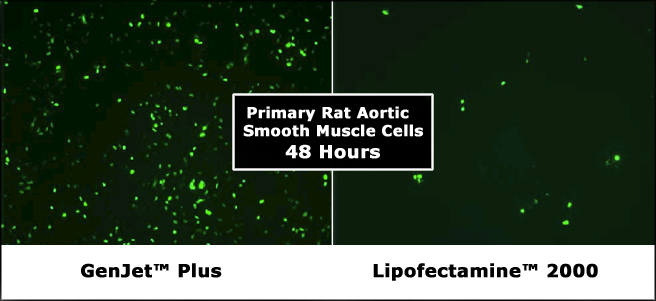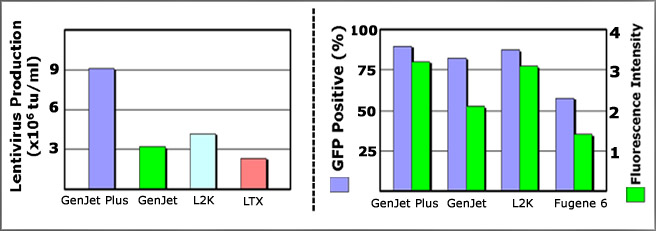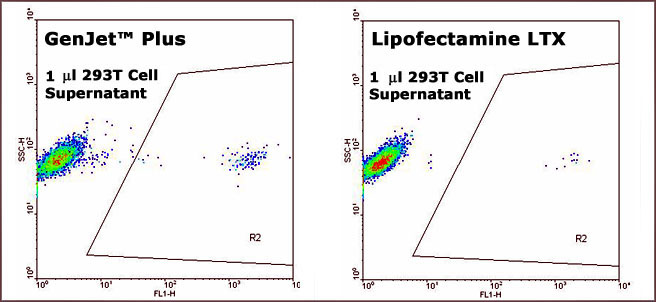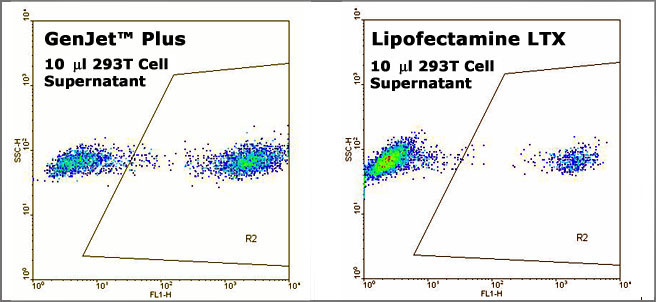EGFIE LLC
We always add value to our customers
Search by Keyword
Product Categories
Based on our unique and proprietary “VIPs” and polymer synthesis technologies, currently we are developing and manufacturing three categories of DNA/siRNA transfection reagents, which show distinct transfection characteristics compared with the leading products in the market. What's more important is that the transfection reagents we are manufacturing are very affordable and will save your precious research budget.
Transfection Reagent Selection Chart.
| Reagents | Features | Transfection Type | Toxicity |
| DNAfect | - Traditional recipe with new formulation - Most affordable and efficient - Best for large scale virus, antibody and protein production |
DNA siRNA DNA/siRNA |
++++ |
| OKDNAfect | - Low toxicity for very sensitive cells - Maximum cell viability |
DNA siRNA DNA/siRNA |
++ |
| SupDNAfect | - 100% DNA condensing groups released - Efficient for commonly used cell types |
DNA siRNA DNA/siRNA |
+++ |
| SupDNAfect Plus |
- Enhanced conjugate for maximal efficiency - Extremely good for very long DNAs |
DNA siRNA DNA/siRNA |
++ |
| LenDNAfect | - Enhanced conjugate with liposome for maximal efficient- Best for lentivirus, antibody and protein production | DNA siRNA DNA/siRNA |
+++ |
| AllDNAfect | - Fluorinated cationic lipids - Best transfection efficiency with least toxicity |
DNA siRNA DNA/siRNA |
+ |
| ExcelDNAfect | - Biodegradable polycationic polymer - Excellent efficiency for common used mammalian cells |
DNA siRNA DNA/siRNA |
+++ |
Description
SupDNAfect Plus DNA ranfection Reagent is enhanced version of GenJet™ DNA In Vitro Transfection Reagent. SupDNAfect Plus is formulated by addition of a booster peptide, giving rise to up to 20 times higher efficiency on variety of mammalian cells in comparison of its previous version. SupDNAfect Plus was shown to efficiently deliver genes to various established cell lines as well as primary cells including HEK293, 293T, 293E, CHO, COS1, HeLa, NIH 3T3, insect cell lines (Sf9 and Sf21) and a variety of other eucaryotic cell lines with less toxicity. SupDNAfect Plus reagent, 1.0 ml, is sufficient for 667 transfections in 24 well plates or 333 transfections in 6 well plates.
Features compared with old version SupDNAfect Transfection Reagent
- Cell-dependent 3~20 times higher efficiency
- Top choice for hard-to-transfect cells
- Equally good for very long DNAs (up to 46 kb)
- Efficiency boosted in the presence of serum and antibiotics for most of cell types
- Exceptional high levels of recombinant protein production
Storage Condition
Store at 4 °C. If stored properly, the product is stable for 12 months or longer.
Comparisons of Transfection Efficiency of SupDNAfect Transfection Reagent with the Leading Brand Name Products

SupDNAfect Plus is top choice for hard-to-transfect cells. Efficiency comparison of SupDNAfect Plus In Vitro DNA Transfection Reagent (left panel) with Lipofectamine 2000 (L2K, right panel) on primary cultured rat aortic smooth muscle cells. A nuclear targeted GFP DNA was transfected with SupDNAfect Plus and L2K respectively per manufacturer's protocols. The efficiency was checked 48 hours post transfection. The above pictures were kindly provided by Dr. Nickolai Dulin of Section of Pulmonary and Critical Care, University of Chicago

Left Panel: Comparison of SupDNAfect Plus In Vitro DNA Transfection Reagent with leading products including Lipofectamine 2000 (L2K) and Lipofectamine LTX (LTX) on lentivirus production on 293T cells. The data were provided by Dr. Miguel Toscano of Temple University as courtesy.
Right panel: Comparison of SupDNAfect Plus In Vitro DNA Transfection Reagent with tranfection reagents from other vendors inluding Lipofectamine 2000 (L2K) and FuGene 6 on Hela cells. HeLa cells were transfected with plasmid DNA encoding GFP. Transfections were performed according to manufacturers recommendations and analysed by flow cytometry.


Exceptional high titers of lentivirus generated from 293T cells. Three DNAs co-transfected with SupDNAfect Plus In Vitro DNA Transfection Reagent (left panel) in comparison of Lipofectamine LTX (right panel). 1.0 and 10 microliters virus supernatant from 293T cells were used to counter-infected 293F cells which was then passed FACS. The numbers at the upper right corner indicate the percentage of transduced cells. The titers of lentivirus generated with SupDNAfect Plus and Lipofectamine LTX were quantified to be 2.1x106 and 9.3x106 tu/ml respectively. The above data were provided by Dr. Miguel Toscano of Temple University as courtesy.
Technical Information & Datasheet
- GenJet™ Plus Data Sheet & General Protocol
- GenJet™ Plus In Vitro DNA Transfection for Lentivirus Production
- GenJet™ Plus In Vitro DNA Transfection for rAAV Production
- Transfection of Sf9 Insect Cells with GenJet™
Related Product: GenJet™ In Vitro DNA Transfection reagent
To request a free trial sample, please email us at customer@egfie.com

Features compared with old version SupDNAfect Transfection Reagent
- Cell-dependent 3~20 times higher efficiency
- Top choice for hard-to-transfect cells
- Equally good for very long DNAs (up to 46 kb)
- Efficiency boosted in the presence of serum and antibiotics for most of cell types
- Exceptional high levels of recombinant protein production
Storage Condition
Store at 4 °C. If stored properly, the product is stable for 12 months or longer.
Comparisons of Transfection Efficiency of SupDNAfect Transfection Reagent with the Leading Brand Name Products

SupDNAfect Plus is top choice for hard-to-transfect cells. Efficiency comparison of SupDNAfect Plus In Vitro DNA Transfection Reagent (left panel) with Lipofectamine 2000 (L2K, right panel) on primary cultured rat aortic smooth muscle cells. A nuclear targeted GFP DNA was transfected with SupDNAfect Plus and L2K respectively per manufacturer's protocols. The efficiency was checked 48 hours post transfection. The above pictures were kindly provided by Dr. Nickolai Dulin of Section of Pulmonary and Critical Care, University of Chicago

Left Panel: Comparison of SupDNAfect Plus In Vitro DNA Transfection Reagent with leading products including Lipofectamine 2000 (L2K) and Lipofectamine LTX (LTX) on lentivirus production on 293T cells. The data were provided by Dr. Miguel Toscano of Temple University as courtesy.
Right panel: Comparison of SupDNAfect Plus In Vitro DNA Transfection Reagent with tranfection reagents from other vendors inluding Lipofectamine 2000 (L2K) and FuGene 6 on Hela cells. HeLa cells were transfected with plasmid DNA encoding GFP. Transfections were performed according to manufacturers recommendations and analysed by flow cytometry.


Exceptional high titers of lentivirus generated from 293T cells. Three DNAs co-transfected with SupDNAfect Plus In Vitro DNA Transfection Reagent (left panel) in comparison of Lipofectamine LTX (right panel). 1.0 and 10 microliters virus supernatant from 293T cells were used to counter-infected 293F cells which was then passed FACS. The numbers at the upper right corner indicate the percentage of transduced cells. The titers of lentivirus generated with SupDNAfect Plus and Lipofectamine LTX were quantified to be 2.1x106 and 9.3x106 tu/ml respectively. The above data were provided by Dr. Miguel Toscano of Temple University as courtesy.
Technical Information & Datasheet
- GenJet™ Plus Data Sheet & General Protocol
- GenJet™ Plus In Vitro DNA Transfection for Lentivirus Production
- GenJet™ Plus In Vitro DNA Transfection for rAAV Production
- Transfection of Sf9 Insect Cells with GenJet™
Related Product: GenJet™ In Vitro DNA Transfection reagent
To request a free trial sample, please email us at customer@egfie.com

Shopping Basket
| Items: | 0 |
| Subtotal: | $0.00 |
Note: All prices in US Dollars
customer@egfie.com